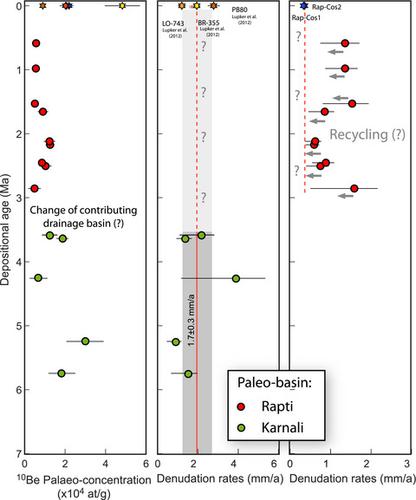当前位置:
X-MOL 学术
›
Basin Res.
›
论文详情
Our official English website, www.x-mol.net, welcomes your feedback! (Note: you will need to create a separate account there.)
A 6 Ma record of palaeodenudation in the central Himalayas from in situ cosmogenic 10 Be in the Surai section
Basin Research ( IF 3.2 ) Pub Date : 2020-10-04 , DOI: 10.1111/bre.12511 Julien Charreau 1 , Jérôme Lavé 1 , Christian France‐Lanord 1 , Nicolas Puchol 1 , Pierre‐Henri Blard 1 , Raphaël Pik 1 , Ananta Prasad Gajurel 2 ,
Basin Research ( IF 3.2 ) Pub Date : 2020-10-04 , DOI: 10.1111/bre.12511 Julien Charreau 1 , Jérôme Lavé 1 , Christian France‐Lanord 1 , Nicolas Puchol 1 , Pierre‐Henri Blard 1 , Raphaël Pik 1 , Ananta Prasad Gajurel 2 ,
Affiliation

|
To better constrain late Neogene denudation of the Himalayas, we analysed in situ 10Be concentrations in 17 Neogene sediment samples of the Surai section (central Nepal) and two modern sediment samples of the Rapti River. We first refined the depositional ages of the Surai section from 36 new paleomagnetic analyses, five 26Al/10Be burial ages, and, based on the Dynamic Time Warping algorithm, 104 automatically calculated likely magnetostratigraphic correlations. We also traced changing sediment sources using major element and Sr‐Nd isotopic data, finding at 4–3 Ma a switch from a large, trans‐Himalayan river to a river draining only the Lesser Himalaya and Siwalik piedmont, increasing the contribution of recycled sediments at that time. 10Be concentrations in Neogene sediments range from (1.00 ± 0.36) to (5.22 ± 0.98) × 103 at g–1 and decrease with stratigraphic age. Based on a flood plain transport model, our refined age model, and assuming a drainage change at 4–3 Ma, we reconstructed 10Be concentrations at the time of deposition. Assuming cosmogenic production rates similar to those of the modern basins, we calculated palaeodenudation rates of 0.9 ± 0.5 to 3.9 ± 2.7 mm a–1 from ca. 6 to 3 Ma in the palaeo‐Karnali basin and 0.6 ± 0.2 to 1.6 ± 0.8 mm a–1 since ca. 3 Ma in the palaeo‐Rapti basin. Given the uncertainties and similar modern values of ~2 mm a–1, the palaeo‐Karnali denudation rates may have been steady at ~1.7 ± 0.3 mm a–1 for the last ca. 6 Ma. A transient acceleration of the denudation in the palaeo‐Rapti basin of ~1.5 mm a–1 since ca. 1.5 Ma was likely due to the reworking of older, 10Be‐depleted Siwalik sediments in the foreland. If true, this steadiness of the denudation rates may suggest that Quaternary glaciations did not largely affect Himalayan denudation.
中文翻译:

来自Surai剖面的原位宇宙成因10 Be在喜马拉雅山脉中部的6 Ma记录
为了更好地限制喜马拉雅山新近纪晚期的剥蚀,我们原位分析了苏莱剖面(尼泊尔中部)的 17 个新近纪沉积物样品和拉普蒂河的两个现代沉积物样品中的 10Be 浓度。我们首先从 36 个新的古地磁分析、5 个 26Al/10Be 埋藏年龄和 104 个基于动态时间扭曲算法的 104 个自动计算可能的磁地层相关性中细化了 Surai 剖面的沉积时代。我们还使用主要元素和 Sr-Nd 同位素数据追踪了不断变化的沉积物来源,发现在 4-3 Ma 时,一条大的跨喜马拉雅河流转变为一条仅排干小喜马拉雅山和西瓦利克山麓的河流,增加了循环沉积物的贡献当时。新近纪沉积物中的 10Be 浓度范围为 (1.00 ± 0.36) 至 (5.22 ± 0。98) × 103 在 g–1 并随着地层年龄而减少。基于洪泛区迁移模型、我们改进的年龄模型,并假设排水量在 4-3 Ma 发生变化,我们重建了沉积时的 10Be 浓度。假设宇宙生成速率与现代盆地相似,我们计算了从大约 0.9 ± 0.5 到 3.9 ± 2.7 mm a-1 的古侵蚀速率。古卡尔纳利盆地 6 至 3 Ma,自约 0.6 ± 0.2 至 1.6 ± 0.8 mm a-1。古拉普蒂盆地 3 Ma。鉴于~2 mm a-1 的不确定性和类似的现代值,古卡纳利剥蚀率可能在最后一个约 1.7 ± 0.3 mm a-1 稳定。6 马。自约 1.5 mm a-1 以来,palaeo-Rapti 盆地中剥蚀的瞬时加速。1.5 Ma 可能是由于前陆较旧的、耗尽 10Be 的 Siwalik 沉积物的再加工。如果属实,
更新日期:2020-10-04
中文翻译:

来自Surai剖面的原位宇宙成因10 Be在喜马拉雅山脉中部的6 Ma记录
为了更好地限制喜马拉雅山新近纪晚期的剥蚀,我们原位分析了苏莱剖面(尼泊尔中部)的 17 个新近纪沉积物样品和拉普蒂河的两个现代沉积物样品中的 10Be 浓度。我们首先从 36 个新的古地磁分析、5 个 26Al/10Be 埋藏年龄和 104 个基于动态时间扭曲算法的 104 个自动计算可能的磁地层相关性中细化了 Surai 剖面的沉积时代。我们还使用主要元素和 Sr-Nd 同位素数据追踪了不断变化的沉积物来源,发现在 4-3 Ma 时,一条大的跨喜马拉雅河流转变为一条仅排干小喜马拉雅山和西瓦利克山麓的河流,增加了循环沉积物的贡献当时。新近纪沉积物中的 10Be 浓度范围为 (1.00 ± 0.36) 至 (5.22 ± 0。98) × 103 在 g–1 并随着地层年龄而减少。基于洪泛区迁移模型、我们改进的年龄模型,并假设排水量在 4-3 Ma 发生变化,我们重建了沉积时的 10Be 浓度。假设宇宙生成速率与现代盆地相似,我们计算了从大约 0.9 ± 0.5 到 3.9 ± 2.7 mm a-1 的古侵蚀速率。古卡尔纳利盆地 6 至 3 Ma,自约 0.6 ± 0.2 至 1.6 ± 0.8 mm a-1。古拉普蒂盆地 3 Ma。鉴于~2 mm a-1 的不确定性和类似的现代值,古卡纳利剥蚀率可能在最后一个约 1.7 ± 0.3 mm a-1 稳定。6 马。自约 1.5 mm a-1 以来,palaeo-Rapti 盆地中剥蚀的瞬时加速。1.5 Ma 可能是由于前陆较旧的、耗尽 10Be 的 Siwalik 沉积物的再加工。如果属实,


























 京公网安备 11010802027423号
京公网安备 11010802027423号